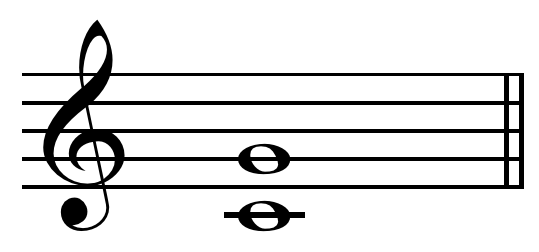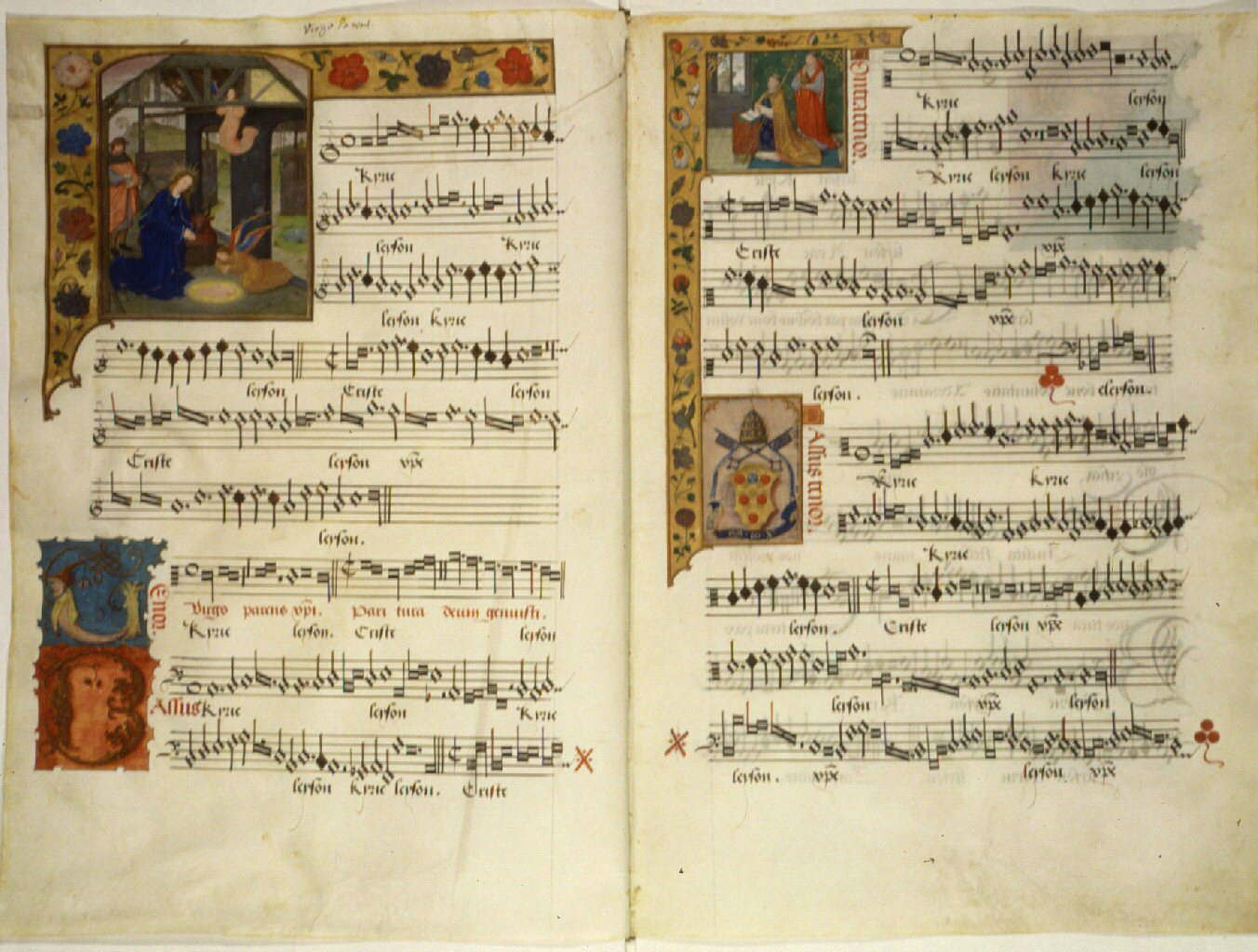|
Hemiola
In music, hemiola (also hemiolia) is the ratio 3:2. The equivalent Latin term is sesquialtera. In rhythm, ''hemiola'' refers to three beats of equal value in the time normally occupied by two beats. In pitch, ''hemiola'' refers to the interval of a perfect fifth. Etymology The word ''hemiola'' comes from the Greek adjective ἡμιόλιος, ''hemiolios'', meaning "containing one and a half," "half as much again," "in the ratio of one and a half to one (3:2), as in musical sounds." The words "hemiola" and "sesquialtera" both signify the ratio 3:2, and in music were first used to describe relations of pitch. Dividing the string of a monochord in this ratio produces the interval of a perfect fifth. Beginning in the 15th century, both words were also used to describe rhythmic relationships, specifically the substitution (usually through the use of coloration—red notes in place of black ones, or black in place of "white", hollow noteheads) of three imperfect notes (divided into t ... [...More Info...] [...Related Items...] OR: [Wikipedia] [Google] [Baidu] |
Cross-beat
In music, a cross-beat or cross-rhythm is a specific form of polyrhythm. The term ''cross rhythm '' was introduced in 1934 by the musicologist Arthur Morris Jones (1889–1980). It refers to a situation where the rhythmic conflict found in polyrhythms is the basis of an entire musical piece. Etymology The term "cross rhythm" was introduced in 1934 by the musicologist Arthur Morris Jones (1889–1980), who, with Klaus Wachsmann, took-up extended residence in Zambia and Uganda, respectively, as missionaries, educators, musicologists, and museologists. African music One main system African cross-rhythm is most prevalent within the greater Niger-Congo linguistic group, which dominates the continent south of the Sahara Desert. (Kubik, p. 58) Cross-rhythm was first identified as the basis of sub-Saharan rhythm by A.M. Jones. Later, the concept was more fully explained in the lectures of Ewe master drummer and scholar C.K. Ladzekpo, and in the writings of David Lo ... [...More Info...] [...Related Items...] OR: [Wikipedia] [Google] [Baidu] |
Polyrhythm
Polyrhythm () is the simultaneous use of two or more rhythms that are not readily perceived as deriving from one another, or as simple manifestations of the same meter. The rhythmic layers may be the basis of an entire piece of music (cross-rhythm), or a momentary section. Polyrhythms can be distinguished from irrational rhythms, which can occur within the context of a single Part (music), part; polyrhythms require at least two rhythms to be played concurrently, one of which is typically an irrational rhythm. Concurrently in this context means within the same rhythmic cycle. The underlying pulse, whether explicit or implicit can be considered one of the concurrent rhythms. For example, the Clave (rhythm)#Son clave, son clave is poly-rhythmic because its 3 section suggests a different meter from the pulse of the entire pattern. In western art music In some European art music, polyrhythm periodically contradicts the prevailing meter. For example, in Wolfgang Amadeus Mozart, Moz ... [...More Info...] [...Related Items...] OR: [Wikipedia] [Google] [Baidu] |
Perfect Fifth
In music theory, a perfect fifth is the Interval (music), musical interval corresponding to a pair of pitch (music), pitches with a frequency ratio of 3:2, or very nearly so. In classical music from Western culture, a fifth is the interval from the first to the last of the first five consecutive Musical note, notes in a diatonic scale. The perfect fifth (often abbreviated P5) spans seven semitones, while the Tritone, diminished fifth spans six and the augmented fifth spans eight semitones. For example, the interval from C to G is a perfect fifth, as the note G lies seven semitones above C. The perfect fifth may be derived from the Harmonic series (music), harmonic series as the interval between the second and third harmonics. In a diatonic scale, the dominant (music), dominant note is a perfect fifth above the tonic (music), tonic note. The perfect fifth is more consonance and dissonance, consonant, or stable, than any other interval except the unison and the octave. It occu ... [...More Info...] [...Related Items...] OR: [Wikipedia] [Google] [Baidu] |
Ostinato
In music, an ostinato (; derived from the Italian word for ''stubborn'', compare English ''obstinate'') is a motif or phrase that persistently repeats in the same musical voice, frequently in the same pitch. Well-known ostinato-based pieces include classical compositions such as Ravel's ''Boléro'' and the '' Carol of the Bells'', and popular songs such as John Lennon’s “Mind Games” (1973), Donna Summer and Giorgio Moroder's " I Feel Love" (1977), Henry Mancini's theme from ''Peter Gunn'' (1959), The Who's " Baba O'Riley" (1971), The Verve's " Bitter Sweet Symphony" (1997), and Flo Rida's " Low" (2007). Both ''ostinatos'' and ''ostinati'' are accepted English plural forms, the latter reflecting the word's Italian etymology. The repeating idea may be a rhythmic pattern, part of a tune, or a complete melody in itself. Kamien, Roger (1258). ''Music: An Appreciation'', p. 611. . Strictly speaking, ostinati should have exact repetition, but in common usage, the term cover ... [...More Info...] [...Related Items...] OR: [Wikipedia] [Google] [Baidu] |
Mensural Notation
Mensural notation is the musical notation system used for polyphony, polyphonic European vocal music from the late 13th century until the early 17th century. The term "mensural" refers to the ability of this system to describe precisely measured rhythmic durations in terms of numerical proportions amongst note values. Its modern name is derived from the terminology of medieval theorists, who used terms like ''musica mensurata'' ("measured music") or ''cantus mensurabilis'' ("measurable song") to refer to the rhythmically defined polyphonic music of their age, as opposed to ''musica plana'' or ''musica choralis'', i.e., Gregorian plainchant. Mensural notation was employed principally for compositions in the tradition of vocal polyphony, whereas plainchant retained its own, older system of neumes, neume notation throughout the period. Besides these, some solely instrumental music could be written in various forms of instrument-specific tablature notation. Mensural notation grew o ... [...More Info...] [...Related Items...] OR: [Wikipedia] [Google] [Baidu] |
Music
Music is the arrangement of sound to create some combination of Musical form, form, harmony, melody, rhythm, or otherwise Musical expression, expressive content. Music is generally agreed to be a cultural universal that is present in all human societies. Definitions of music vary widely in substance and approach. While scholars agree that music is defined by a small number of elements of music, specific elements, there is no consensus as to what these necessary elements are. Music is often characterized as a highly versatile medium for expressing human creativity. Diverse activities are involved in the creation of music, and are often divided into categories of musical composition, composition, musical improvisation, improvisation, and performance. Music may be performed using a wide variety of musical instruments, including the human voice. It can also be composed, sequenced, or otherwise produced to be indirectly played mechanically or electronically, such as via a music box ... [...More Info...] [...Related Items...] OR: [Wikipedia] [Google] [Baidu] |
Michael Kennedy (music Critic)
George Michael Sinclair Kennedy CBE (19 February 1926 – 31 December 2014) was an English music critic and author who specialized in classical music. For nearly two decades he was the chief classical music critic for both ''The Daily Telegraph'' (1986–2005) and ''The Sunday Telegraph'' (1989–2005). A prolific writer, he was the biographer of many composers and musicians, including Vaughan Williams, Elgar, Barbirolli, Mahler, Strauss, Britten, Boult and Walton. Other notable publications include writings on various musical institutions, the editing of music dictionaries as well as numerous articles for ''The New Grove Dictionary of Music and Musicians'' and the subsequent ''Grove Music Online''. Life and career On 19 February 1926 Kennedy was born in Chorlton-cum-Hardy, Manchester, and attended Berkhamsted School. On 17 November 1941, he joined the Manchester office of ''Daily Telegraph'' at age 15, as a tea boy. In his youth, Kennedy auditioned for a role in t ... [...More Info...] [...Related Items...] OR: [Wikipedia] [Google] [Baidu] |
Gyil
The balafon (pronounced , or, by analogy with ''xylophone'' etc., ) is a gourd-resonated xylophone, a type of struck idiophone. It is closely associated with the neighbouring Mandé, Bwaba Bobo, Senoufo and Gur peoples of West Africa, particularly the Guinean branch of the Mandinka ethnic group, but is now found across West Africa from Guinea, Burkina Faso, Mali. Its common name, ''balafon'', is likely a European coinage combining its Mandinka name ''bala'' () with the word ''fôn'' () 'to speak' or the Greek root ''phono''. History Believed to have been developed independently of the Southern African and South American instrument now called the marimba, oral histories of the balafon date it to at least the rise of the Mali Empire in the 12th century CE. Balafon is a Manding name, but variations exist across West Africa, including the ''balangi'' in Sierra Leone and the gyil of the Dagara, Lobi and Gurunsi from Ghana, Burkina Faso and Ivory Coast. Similar instrum ... [...More Info...] [...Related Items...] OR: [Wikipedia] [Google] [Baidu] |
Shape
A shape is a graphics, graphical representation of an object's form or its external boundary, outline, or external Surface (mathematics), surface. It is distinct from other object properties, such as color, Surface texture, texture, or material type. In geometry, ''shape'' excludes information about the object's Position (geometry), position, size, Orientation (geometry), orientation and chirality. A ''figure'' is a representation including both shape and size (as in, e.g., figure of the Earth). A plane shape or plane figure is constrained to lie on a ''plane (geometry), plane'', in contrast to ''solid figure, solid'' 3D shapes. A two-dimensional shape or two-dimensional figure (also: 2D shape or 2D figure) may lie on a more general curved ''surface (mathematics), surface'' (a two-dimensional space). Classification of simple shapes Some simple shapes can be put into broad categories. For instance, polygons are classified according to their number of edges as triangles, qua ... [...More Info...] [...Related Items...] OR: [Wikipedia] [Google] [Baidu] |
Rhythmic Cell
The 1957 ''Encyclopédie Larousse''quoted in Nattiez, Jean-Jacques (1990). ''Music and Discourse: Toward a Semiology of Music'' (''Musicologie générale et sémiologue'', 1987). Translated by Carolyn Abbate (1990). . defines a cell in music as a "small rhythmic and melodic design that can be isolated, or can make up one part of a thematic context". The cell may be distinguished from the figure or motif: the 1958 ''Encyclopédie Fasquelle'' defines a cell as "the smallest indivisible unit", unlike the motif, which may be divisible into more than one cell. "A cell can be developed, independent of its context, as a melodic fragment, it can be used as a developmental motif. It can be the source for the whole structure of the work; in that case it is called a generative cell." A rhythmic cell is a cell without melodic connotations. It may be entirely percussive or applied to different melodic segments. History The term "cell" (German: ''Keim'') derives from organic music theorists ... [...More Info...] [...Related Items...] OR: [Wikipedia] [Google] [Baidu] |
Paul Laird
Paul Robert Laird (born October 26, 1958) is an American musicologist at the University of Kansas born in Louisville, Kentucky. Education Raised in Bridgewater Township, New Jersey, Laird graduated in 1976 from Bridgewater-Raritan High School East, where he participated in the New Jersey All-State Orchestra. Laird holds a Ph.D. in music from the University of North Carolina at Chapel Hill. His research interests include the Spanish and Latin American villancico, Leonard Bernstein, the Broadway musical, and Baroque cello. He has taught at Pennsylvania State University, Binghamton University and the University of Denver. Reviewer Alvaro Torrente described Laird's book ''Towards a History of the Spanish Villancico'' as "a milestone in the study of the villancico." Publications He directs the Instrumental Collegium Musicum and is active as a Baroque cellist, performing with the Spencer Consort. In August 2002, he won a University of Kansas W. T. Kemper Fellowship for Teaching ... [...More Info...] [...Related Items...] OR: [Wikipedia] [Google] [Baidu] |





